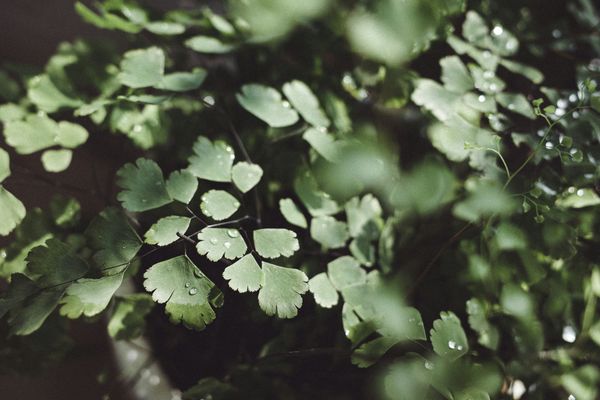Maidenhair Fern Care Guide
How to grow and care for Maidenhair Fern (Adiantum raddianum)
The Adiantum raddianum, commonly known as the Maidenhair Fern, is a charming and delicate houseplant beloved for its lacy, fan-shaped fronds that gracefully arch from wiry black stems. Originating from the humid, forested areas of South America, this fern thrives in similarly moist and protected indoor environments. With the right care, Maidenhair Ferns can provide a lush and vibrant touch to your home decor, enchanting plant enthusiasts and indoor gardeners of all experience levels.

Disclosure: This content includes affiliate links, which means we may earn a commission if you click on a link and make a purchase. As an Amazon Associate, we earn from qualifying purchases. This comes at no extra cost to you and helps offset the cost of running Leafwise. Please read our disclaimer for more info.
Table of Contents
Care
Light
Maidenhair Ferns prefer bright, indirect light and should be placed where they have a wide view of the open sky but no direct sun exposure. Direct sunlight can easily scorch their delicate fronds. East- or north-facing windows work well, or use sheer curtains to filter the light in brighter rooms.
Watering
These ferns require consistently moist soil, and the soil should never be allowed to dry out completely. Even a brief dry period can cause the fronds to shrivel. Water when the top inch of soil feels dry. Use room-temperature, filtered water if possible, as Maidenhair Ferns are sensitive to chlorine and other chemicals often found in tap water. Rainwater is also an excellent alternative if available.
Humidity
High humidity is crucial for Maidenhair Ferns. Aim to maintain a humidity level of at least 60–70%. Use a pebble tray, mist the plant regularly, or place it near a humidifier to meet its humidity needs. Bathrooms with bright, indirect light are also excellent locations due to naturally higher moisture levels.
Temperature
Keep temperatures ideally above 70°F (21°C) and avoid allowing the temperature to fall below 60°F (15°C). Protect the plant from cold drafts, air conditioners, and sudden temperature fluctuations, which can stress or damage the fronds.
Soil
Use a well-draining potting mix enriched with organic matter. A peat-based mix or a combination of peat and pine bark provides ideal moisture retention and aeration. To improve drainage and airflow, consider incorporating coarse sand or perlite. Ensure the pot has drainage holes to prevent root rot.
Maintenance
Fertilizing
Feed your Maidenhair Fern monthly during the growing season (spring and summer) using a balanced, water-soluble fertilizer diluted to half strength. Avoid fertilizing during fall and winter when the plant's growth naturally slows.
Pruning
Regularly remove any browned, wilted, or dead fronds at the base to promote healthy new growth. Prune in early spring or as needed to keep the plant looking tidy.
Repotting
Repot annually in the spring if the roots have outgrown the container. Signs that the fern is root-bound include roots circling the inside of the pot or growing out of the drainage holes. Use a pot that is only slightly larger than the current one to avoid excessive soil moisture and potential root issues. Refresh the soil when repotting.
Propagation
Maidenhair Ferns can be propagated through division:
- Divide the plant during repotting in early spring.
- Gently separate a healthy clump with roots and fronds attached.
- Replant the division in a small pot with moist, well-draining soil.
- Maintain high humidity and bright, indirect light while the new plant establishes.
Common Issues
Pests
- Cause: Dry air, dusty leaves, nearby infested plants, low humidity, or poor air circulation.
- Symptoms: Presence of aphids, scale, or spider mites; visible webbing, sticky residue (honeydew), small brown bumps, or yellowing fronds.
- Solution: Increase humidity and improve air circulation. Wipe fronds with a damp cloth and treat infestations with insecticidal soap or neem oil. Repeat applications weekly until pests are controlled. Maintain humidity and clean leaves regularly to prevent recurrence.
Root Rot
- Cause: Overwatering, poor drainage, or prolonged exposure to soggy soil.
- Symptoms: Yellowing, wilting fronds, mushy roots, a musty odor, and eventual leaf drop.
- Solution: Remove the plant from its pot, trim off affected roots, and repot in fresh, well-draining soil. Ensure the new pot has drainage holes, and adjust your watering schedule to prevent recurrence.
Yellowing Leaves
- Cause: Overwatering, low humidity, or insufficient light.
- Symptoms: Fronds gradually turn yellow or pale.
- Solution: Check moisture levels and lighting. Increase humidity and consider relocating the plant to a brighter, indirect light source.
With attentive care and the right environment, your Maidenhair Fern can thrive as a lush, graceful addition to your indoor plant collection. Be sure to monitor seasonal changes in light and humidity to maintain the best conditions year-round.
